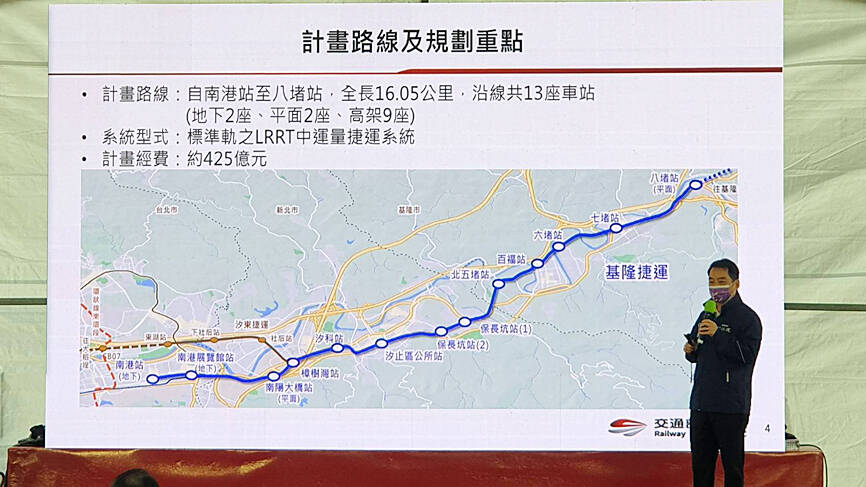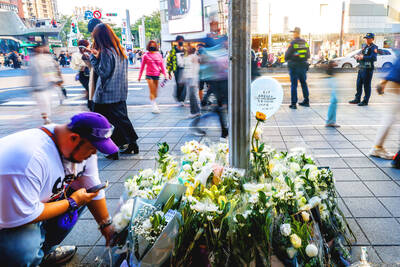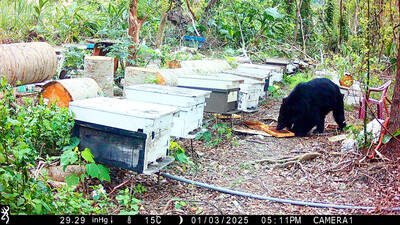The Keelung City Government could avoid a “financial dark period” when building the Keelung MRT line if it focuses on property development along the MRT route, Minister of Transportation and Communications Wang Kwo-tsai (王國材) said yesterday.
The plan to construct a 16.5km MRT line connecting Badu Railway Station in Keelung and Nangang Railway Station in Taipei was finalized during the administration of former Keelung mayor Lin Yu-chang (林右昌), of the Democratic Progressive Party, who now serves as minister of the interior.
Keelung Mayor Hsieh Kuo-liang (謝國樑), of the Chinese Nationalist Party (KMT), said during a live broadcast on Facebook on Sunday that the city must pay NT$5.386 billion (US$176.15 million) toward building the MRT line — three times more than the previous estimate.

Photo: Lu Hsiu-hsien, Taipei Times
That would cause Keelung to plunge into a “dark period” financially, Hsieh said, adding that the central government should pay the full cost.
The Keelung MRT line is expected to cost NT$69.7 billion, NT$51.4 billion of which would be paid by the central government, while the remaining NT$18.3 billion would be paid by the Taipei, Keelung and New Taipei City governments, Wang said.
“The government has a consistent way of dividing the share of construction costs for MRT systems. The Keelung City Government could consider developing properties along the Keelung MRT line, controlling the cost of drafting land from private owners to build the MRT line and focusing on increasing revenue that could be generated through the operation of the line,” he said.
The Railway Bureau said that the current city government was not asked to pay more because of political considerations.
“Construction material costs have risen dramatically in recent years. The city government changed the method of acquiring land to build the MRT line from ‘segment expropriation’ to ‘general expropriation,’ which has also driven up the cost. As the Keelung City Government’s fiscal status has been upgraded from Level 4 to Level 3, the percentage of construction funds paid by the central government has dropped from 86 percent to 84 percent. As such, Keelung’s share of the costs has tripled from NT$1.77 billion to NT$5.386 billion,” the bureau said.

SHIPS, TRAINS AND AUTOMOBILES: The ministry has announced changes to varied transportation industries taking effect soon, with a number of effects for passengers Beginning next month, the post office is canceling signature upon delivery and written inquiry services for international registered small packets in accordance with the new policy of the Universal Postal Union, the Ministry of Transportation and Communications said yesterday. The new policy does not apply to packets that are to be delivered to China, the ministry said. Senders of international registered small packets would receive a NT$10 rebate on postage if the packets are sent from Jan. 1 to March 31, it added. The ministry said that three other policies are also scheduled to take effect next month. International cruise ship operators

HORROR STORIES: One victim recounted not realizing they had been stabbed and seeing people bleeding, while another recalled breaking down in tears after fleeing A man on Friday died after he tried to fight the knife-wielding suspect who went on a stabbing spree near two of Taipei’s busiest metro stations, Taipei Mayor Chiang Wan-an (蔣萬安) said. The 57-year-old man, identified by his family name, Yu (余), encountered the suspect at Exit M7 of Taipei Main Station and immediately tried to stop him, but was fatally wounded and later died, Chiang said, calling the incident “heartbreaking.” Yu’s family would receive at least NT$5 million (US$158,584) in compensation through the Taipei Rapid Transit Corp’s (TRTC) insurance coverage, he said after convening an emergency security response meeting yesterday morning. National

PLANNED: The suspect visited the crime scene before the killings, seeking information on how to access the roof, and had extensively researched a 2014 stabbing incident The suspect in a stabbing attack that killed three people and injured 11 in Taipei on Friday had planned the assault and set fires at other locations earlier in the day, law enforcement officials said yesterday. National Police Agency (NPA) Director-General Chang Jung-hsin (張榮興) said the suspect, a 27-year-old man named Chang Wen (張文), began the attacks at 3:40pm, first setting off smoke bombs on a road, damaging cars and motorbikes. Earlier, Chang Wen set fire to a rental room where he was staying on Gongyuan Road in Zhongzheng District (中正), Chang Jung-hsin said. The suspect later threw smoke grenades near two exits

The Forestry and Nature Conservation Agency yesterday launched a gift box to market honey “certified by a Formosan black bear” in appreciation of a beekeeper’s amicable interaction with a honey-thieving bear. Beekeeper Chih Ming-chen (池明鎮) in January inspected his bee farm in Hualien County’s Jhuosi Township (卓溪) and found that more than 20 beehives had been destroyed and many hives were eaten, with bear droppings and paw prints near the destroyed hives, the agency said. Chih returned to the farm to move the remaining beehives away that evening when he encountered a Formosan black bear only 20m away, the agency said. The bear